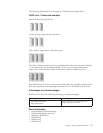
value that is close to the size of the system I/O requests. For example,
performance in transaction-based environments, which typically involve large
blocks of data, might be optimal when the stripe-unit size is set to 32 KB or 64 KB.
However, performance in file and print environments, which typically involve
multiple small blocks of data, might be optimal when the stripe-unit size is set to
8 KB or 16 KB.
The ServeRAID-7t, ServeRAID-8i, ServeRAID-8k/8k-l, and
HostRAID controllers do not support an 8 KB stripe-unit size. The ServeRAID-7t
ServeRAID-8i, and ServeRAID-8k/8k-l controllers support these additional
stripe-unit sizes: 128 KB, 256 KB, 512 KB, and 1024 KB.
The collection of stripe units, from the first drive of the array to the last drive of
the array, is called a stripe.
After you configure an array and store data on the logical drives, you
cannot change the stripe-unit size without destroying data in the logical drives.
You can set the stripe-unit size to 8 KB, 16 KB, 32 KB, or 64 KB. The default setting
is 8 KB data bytes.
v When the stripe-unit size is 8 KB or 16 KB, the maximum number of physical
drives in an array is 16.
v If you have a ServeRAID-3H or ServeRAID-3HB controller using ServeRAID
firmware (version 4.0, or later) and the stripe-unit size is 32 KB or 64 KB, the
maximum number of physical drives in an array is 16. Otherwise, when the
stripe-unit size is 32 KB or 64 KB, the maximum number of physical drives in an
array is 8.
v If you have a ServeRAID-4 controller and the stripe-unit size is set to 32 KB or
64 KB, the maximum number of physical drives in an array is 16.
More information
v Changing the stripe-unit size (action)
v Application environment groups reference
Understanding RAID level-0
RAID level-0 stripes the data across all the drives in the array. This offers
substantial speed enhancement, but provides no data redundancy. RAID level-0
provides the largest storage capacity of the RAID levels that are offered, because
no room is taken for redundant data or data-parity storage.
RAID level-0 requires a minimum of one drive and, depending upon the level of
firmware and the stripe-unit size, supports a maximum of 8 or 16 drives.
For ServeRAID-8i, ServeRAID-8k/8k-l, ServeRAID-7t, and
HostRAID controllers, RAID level-0 requires a minimum of two drives.
The following illustration shows an example of a RAID level-0 logical drive.
Chapter 3. Using ServeRAID Manager 33


















